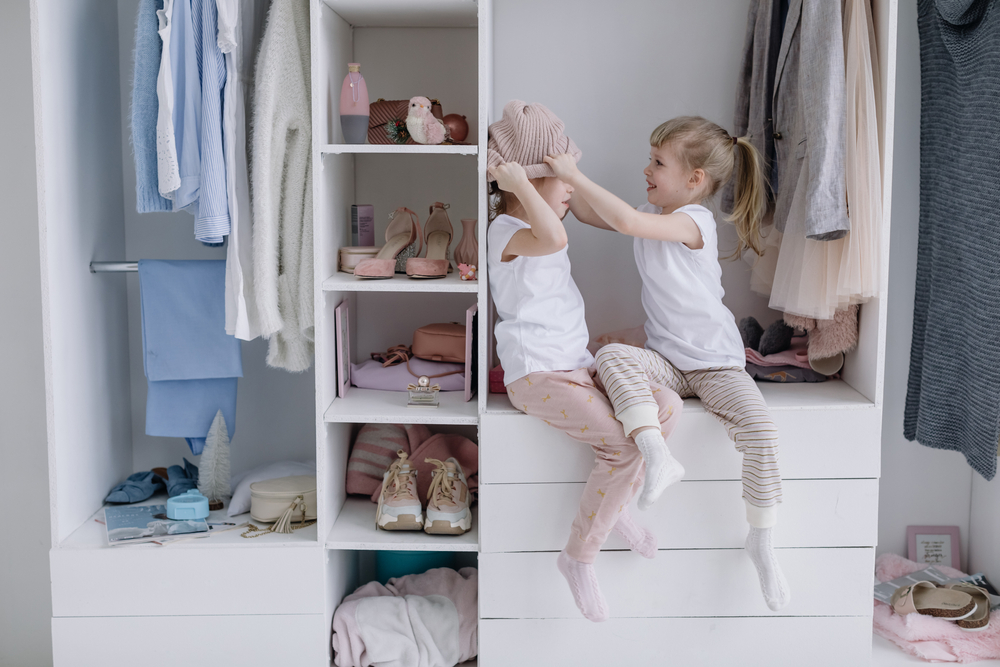Designing a child’s closet goes beyond simply finding a place to store clothes—it’s about creating a space that promotes organization, independence, and even a bit of fun. A well-thought-out closet can transform a chaotic room into a tidy haven, making daily routines smoother for both kids and parents. The right combination of custom closets, clever closet organizers, and tailored closet accessories can help maximize space while accommodating a child’s ever-changing needs. From adjustable shelves to playful storage solutions, a carefully crafted closet design sets the stage for lifelong organizational habits. (Source: Better Homes and Gardens, Kids’ Closet Organization Ideas, Caitlin Sole, June 20, 2020, https://www.bhg.com/rooms/kids-rooms/storage/kid-friendly-closet-ideas/ ).
Storage Tips for Kids’ Closets
In children’s closets, maintaining visibility and accessibility is crucial. Shallow drawers, cubbies, and storage bins allow kids to see and reach their belongings easily, preventing clutter from building up.
The Closet Company shares, “Custom closet designs for kids should prioritize accessibility. Adjustable shelves and modular components ensure that children can actively participate in organizing their belongings, which helps cultivate responsibility and independence.”
Storage Solutions for Two
Shared closets often present unique challenges. Dividing storage space equitably between two children can reduce conflicts and keep the area organized. Symmetrical designs with individual storage zones make it easier for each child to maintain their own section.
The Closet Company comments, “Closet organizers for shared spaces benefit greatly from clear boundaries. Whether it’s through separate drawers, shelves, or even color-coded storage bins, these divisions help streamline morning routines and ensure both kids feel ownership over their space.”
Make the Most of Storage Space
Efficient use of vertical space is a game-changer in small closets. Installing double hanging rods or utilizing the upper sections of the closet for less frequently used items can significantly increase storage capacity.
The Closet Company notes, “Any closet design should take advantage of every inch of available space. High shelves for out-of-season clothes or memory boxes, combined with lower, kid-friendly drawers and bins, create a layered storage system that maximizes usability.”
Choose Closet Storage That Grows
Closets that adapt as children grow are an investment in long-term organization. Features like adjustable shelving or expandable rods can accommodate changes in wardrobe size and style over the years.
The Closet Company shares, “Designing a closet with growth in mind ensures it remains practical through various stages of childhood. This adaptability minimizes the need for frequent overhauls and keeps the space functional for years to come.”
Make It Easy to Get Organized
Labels and visual cues help young children understand where items belong, making tidying up an easier and quicker process. Using clear bins or picture labels can also turn organizing into a learning opportunity.
The Closet Company expresses, “Closet accessories like labeled baskets or transparent storage boxes teach children to categorize and sort their belongings. This not only maintains order but also fosters an early understanding of organizational principles.”
Easy Ideas for a Custom Closet
Incorporating simple yet effective tools like dividers, baskets, and hooks can create a more functional space. These accessories help define areas for specific items, reducing the likelihood of messes.
The Closet Company highlights, “Custom closets can be both simple and highly effective. Even without elaborate designs, thoughtful planning can make a big difference. Prioritizing functionality by tailoring the layout to fit a child’s daily routines helps ensure the space remains organized and easy to use. Simple adjustments, like lowering hanging rods for younger kids or adding more shelving as they grow, can keep the closet practical and adaptable over time.”
Plan Your Storage Space
Involving children in the planning process can lead to a more tailored and engaging closet design. Allowing kids to have input on how their space is organized can encourage them to maintain it.
The Closet Company shares, “When children feel a sense of ownership over their closet, they’re more likely to keep it organized. Incorporating their ideas, whether it’s picking colors or deciding where certain items go, makes the space uniquely theirs.”
Keep Storage Easy
Simplicity is key when designing a child’s closet. Easy-to-use storage solutions, such as open shelves and low-hanging rods, empower children to manage their items independently.
The Closet Company says, “Closets designed with straightforward, user-friendly systems make it easy for kids to maintain order without constant supervision. This simplicity ensures the closet remains functional and clutter-free over time.”
Have Fun with Storage
Adding playful elements to a closet can make the space more inviting and encourage kids to take pride in keeping it tidy. Bright colors, whimsical hooks, or themed storage bins add personality and fun.
The Closet Company highlights, “Closet accessories play a crucial role in keeping a child’s space neat and functional. Items like drawers and specialty racks offer enclosed storage for everything from clothes to toys, while adjustable closet poles make it easy to hang garments of all sizes as kids grow. Hampers and baskets are perfect for sorting laundry or stashing miscellaneous items, keeping clutter at bay. Shoe storage options, whether shelves, cubbies, or racks, ensure every pair has a home. With shelf dividers or smaller drawers, even larger spaces can be neatly divided, making it simple to organize folded clothes, books, or accessories. Together, these elements create a customized, user-friendly system that helps maintain order and teaches kids valuable organizational habits.”
Creating a functional and engaging closet for children requires a blend of thoughtful design, flexibility, and creativity. From using adaptable storage solutions to incorporating playful elements, a well-organized closet can grow with the child, providing both practical benefits and an enjoyable environment.
